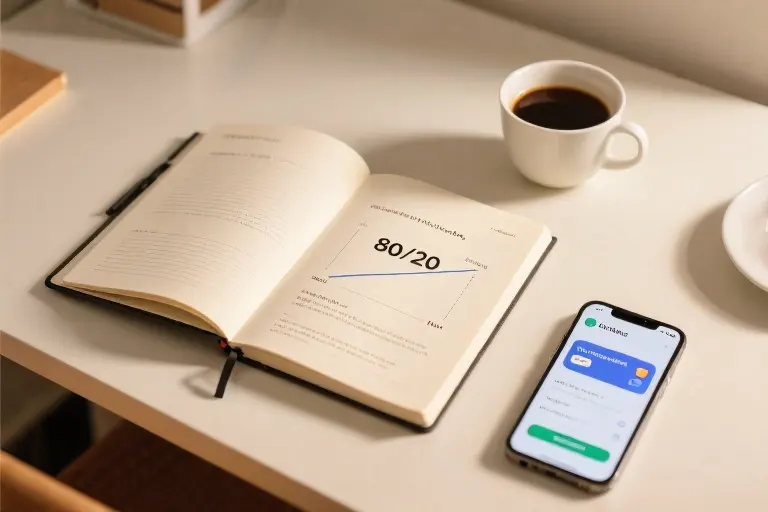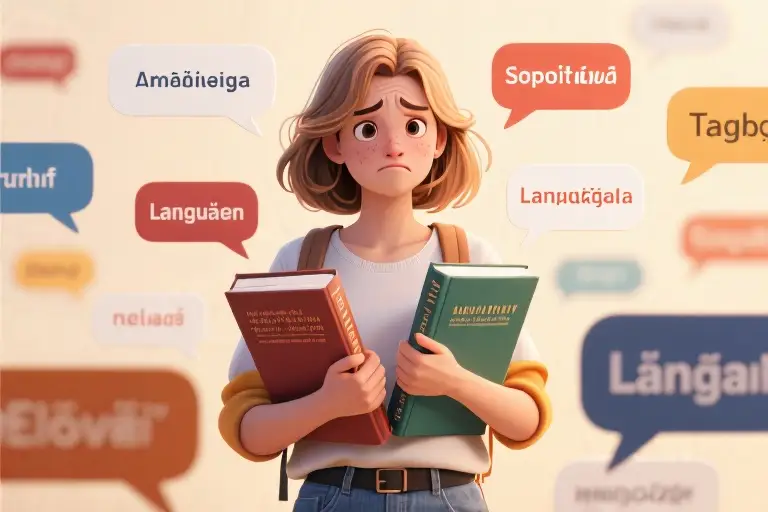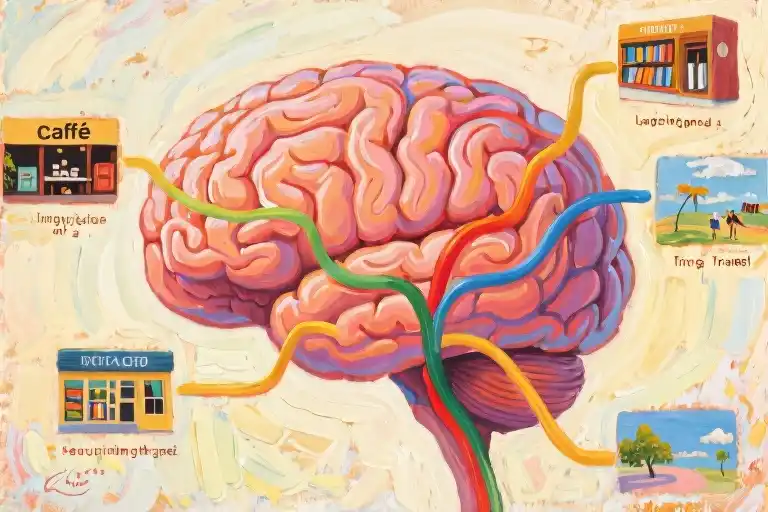The first time I attempted to learn German, I approached it with the enthusiasm of someone preparing for a PhD defense. My desk disappeared under grammar books thicker than medieval manuscripts. Color-coded conjugation charts papered my walls like some linguistic crime scene. For six obsessive months, I treated vocabulary acquisition like a military operation – yet when I finally stumbled into a Berlin café, all I could muster was a panicked “Entschuldigung… toilette?”
This wasn’t just a personal failure – it revealed a fundamental flaw in how most adults approach language learning. We operate under three dangerous assumptions:
- The More-The-Better Myth: That progress correlates directly with hours spent memorizing
- The Perfection Trap: Believing we must master everything before daring to speak
- The Textbook Fallacy: Thinking languages are learned through systematic study rather than strategic use
What my neon-highlighted German nightmare taught me? Traditional methods make language learning unnecessarily difficult. The breakthrough came when I discovered business strategist Vilfredo Pareto’s 80/20 principle – the observation that 80% of outcomes flow from 20% of inputs. Applied to language acquisition:
- 20% of vocabulary (about 300-400 words) covers 80% of daily conversations
- Core grammar structures (present tense, basic questions) handle most communication needs
- Early speaking practice yields faster progress than years of passive study
This isn’t theoretical. Research from the University of Lyon analyzed 60 languages, finding consistent patterns:
| Vocabulary Size | Conversation Coverage |
|---|---|
| 300 words | 65% |
| 1,000 words | 85% |
| 3,000 words | 98% |
Yet most courses and apps bombard beginners with thousands of low-frequency words (looking at you, “quintessential” and “magnanimous”). We waste months on grammar exceptions while neglecting the structures that appear in every conversation.
The psychological toll is worse than the inefficiency. Language learners report:
- Decision fatigue from overwhelming resource choices
- Shame cycles when “comprehensive” programs go unfinished
- Communication paralysis – knowing much but saying little
Here’s the paradigm shift: Fluency isn’t about how much you know, but how effectively you use what you know. My students who embrace this minimalist approach typically reach conversational comfort in 3-6 months with just 30 daily minutes – less time than many spend researching learning methods.
The secret lies in working smarter across three dimensions:
- Content Minimalism: Identifying the highest-yield words and grammar
- Time Minimalism: Focused 30-minute daily practice sessions
- Perfectionism Minimalism: Prioritizing communication over correctness
This isn’t about cutting corners – it’s about cutting clutter. Like packing for travel, the art lies in knowing what to leave behind so you can move freely. In the next sections, we’ll map out exactly how to build your personalized 20% toolkit and start making tangible progress from Day 1.
Why Traditional Methods Keep You Stuck
Language learning often feels like running on a treadmill—you’re putting in the effort but not getting anywhere. I know this frustration firsthand. During my German learning journey, I filled notebooks with verb conjugations, highlighted textbooks like a medieval scribe, and still couldn’t order coffee without breaking into a sweat. The turning point came when I discovered a counterintuitive truth: doing less actually gets you further.
The 80/20 Principle in Language Learning
The Pareto Principle—originally observed in economics—reveals that 80% of outcomes come from 20% of inputs. Applied to language acquisition:
- Vocabulary: Research shows that knowing just 300-500 high-frequency words lets you understand ~75% of everyday conversations (e.g., Oxford 3000 list for English).
- Grammar: Mastering present tense + basic questions covers most speaking needs initially.
- Time Investment: Short, daily practice beats marathon weekend sessions for retention.
Example: In Spanish, verbs like ser (to be), tener (to have), and querer (to want) appear 3x more frequently than niche verbs like tejer (to knit). Prioritizing these unlocks immediate communication.
The Efficiency Gap: Traditional vs. Minimalist Learning
| Traditional Approach | Minimalist 80/20 Method |
|---|---|
| Cramming 5,000 words before speaking | Learning 200 high-utility words first |
| Memorizing all verb tenses | Using present tense + time phrases (yesterday, tomorrow) |
| Delaying conversation until “ready” | Speaking from Day 1 with “good enough” grammar |
| 2-hour weekly study marathons | 30-minute daily focused practice |
A Cambridge University study found learners using frequency-based word lists progressed 40% faster in speaking tests than those following standard curricula. The reason? They spent time on what actually matters.
Breaking the Overlearning Cycle
Three signs you’re wasting effort:
- The “Castle Syndrome”: Studying obscure vocabulary (moat, drawbridge) instead of practical terms (bathroom, check-in).
- Grammar Paralysis: Refusing to speak until mastering subjunctive mood—like refusing to drive until you can rebuild an engine.
- App Addiction: Collecting language apps like Pokémon without consistent practice in any.
Pro Tip: If a word/rule doesn’t help you:
- Ask for directions
- Share an opinion
- Tell a simple story
…skip it for now. You can always learn it later when context demands.
The Psychology Behind “Less is More”
Our brains naturally prioritize frequently encountered information. By focusing on the 20% that appears everywhere:
- Spaced repetition happens organically (you’ll see hello daily)
- Contextual learning sticks better (words used in real sentences > flashcard isolation)
- Motivation stays higher because progress feels tangible
As linguist Paul Nation notes: “Fluency isn’t about how much you know—it’s about how readily you can use what you know.”
Your First Step Today
Open your notes or language app. Cross out anything that:
- You’ve never heard in a movie/song/conversation
- Doesn’t help express basic needs/thoughts
- Feels like “I should know this” rather than “I want to use this”
What remains? That’s your 20% golden list. Start there.
The Minimalist Language Learning Framework: 4 Steps That Actually Work
Let’s cut straight to the chase: language learning doesn’t require encyclopedic knowledge or military discipline. What it does need is strategic focus – identifying the 20% of effort that yields 80% of real-world communication ability. Here’s the battle-tested framework I wish someone had handed me when I first burned out trying to learn German.
Step 1: High-Frequency Vocabulary Filtering
Every language has its workhorse words – the linguistic equivalent of a chef’s most used knives. Research shows that just 300-500 words typically cover about 75% of daily conversations. My approach:
- Start with semantic primitives: Concepts like ‘want’, ‘go’, ‘see’, ‘good’, ‘bad’ that form building blocks for countless sentences
- Prioritize utility over prestige: Skip Shakespearean vocabulary unless you’re actually performing Hamlet
- Use spaced repetition smartly: Tools like Anki work best when cards contain whole phrases (“Can I get…” rather than isolated words)
Pro Tip: The Oxford 3000 list for English or equivalent frequency dictionaries for other languages make excellent starting points.
Step 2: Early Speaking Strategy (Embrace the Awkward)
The psychological barrier to speaking is often greater than the linguistic one. Here’s how to break through:
- The 1×1 Method: One new word + one known grammar structure daily (“Yesterday I [new verb]”)
- Self-talk practice: Narrate your morning routine aloud (“Now I’m brushing teeth. Toothpaste tastes minty.”)
- Error reframing: View mistakes as diagnostic tools rather than failures
True Story: My first Italian conversation involved accidentally declaring myself to be a cup of coffee. The barista laughed – then became my first language exchange partner.
Step 3: Real-World Simulation
Language lives in context. Before you’re ready for actual conversations, try these low-pressure simulations:
- Text message roleplay: Write imaginary chats (planning meetups, ordering food)
- Audio journaling: 60-second daily recordings about your day
- Environmental labeling: Stick post-it notes on household items with target language names
Key Insight: These exercises activate neural pathways differently than passive app exercises, creating more durable memory traces.
Step 4: Grammar Minimalism
Think of grammar as seasoning rather than the main dish:
- Essential starter pack: Present tense, basic questions, negation, key pronouns
- Contextual learning: Notice patterns in the phrases you’re already using
- Delayed perfectionism: Postpone complex tenses until you’re regularly using simpler ones
Helpful Metaphor: Grammar is like salt – necessary in small amounts, but nobody wants to eat a spoonful of it.
Why This Framework Works
- Cognitive load management: Avoids overwhelming working memory
- Quick wins: Visible progress maintains motivation
- Transferability: Skills build cumulatively rather than in isolation
- Psychological safety: Reduces fear of imperfection
The magic happens when these steps interact – the vocabulary you learn gets used in speaking practice, which reveals grammar needs, which then improves your simulations. It’s a virtuous cycle disguised as a simple method.
Remember: Fluency isn’t about how much you know, but how readily you can use what you know. That’s the heart of minimalist language learning.
The 30-Minute Blueprint for Busy Language Learners
Time-strapped professionals often assume language mastery requires monastic devotion—two-hour daily study marathons, textbook highlighters drained dry, and caffeine-fueled grammar cram sessions. The truth? Consistent 30-minute investments with strategic focus outperform erratic binge-learning every time. Here’s how to structure your half-hour for maximum real-world impact.
The Golden Ratio: 10/10/10
Vocabulary Sprint (10 minutes)
Target high-frequency words through:
- Spaced repetition apps (Anki, Memrise) with pre-made decks like “Top 200 Spanish Verbs”
- The “Sticky Note Method”: Label 5 household items daily with target language equivalents
- Audio flashcards during commutes using apps like Clozemaster
Conversation Lab (10 minutes)
Early speaking practice options:
- Shadowing podcasts at 0.75x speed (try Coffee Break Languages)
- Recording voice memos describing your day
- Language exchange apps (HelloTalk, Tandem) for 5-minute text/voice exchanges
Immersion Snack (10 minutes)
Passive absorption techniques:
- Watching Netflix with Language Reactor extension
- Reading news summaries (DW Learn German, News in Slow French)
- Following target language influencers on Instagram
Real-World Implementation Examples
Morning Routine (Before Work):
- 7:00am: Review 10 Anki cards while brewing coffee (vocabulary)
- 7:10am: Describe breakfast ingredients aloud in target language (speaking)
- 7:20am: Listen to language-learning podcast during shower (immersion)
Lunch Break Hack:
- 12:30pm: Label lunch items on phone notepad (vocabulary)
- 12:40pm: Record imaginary restaurant order (speaking)
- 12:50pm: Scroll through language meme accounts (immersion)
Tools That Earn Their Keep
| Category | Free Options | Premium Upgrades |
|---|---|---|
| Vocabulary | Anki, Quizlet | LingQ, Drops |
| Speaking | HelloTalk, Tandem | Preply, iTalki tutors |
| Immersion | YouTube, Podcasts | FluentU, Lingopie |
Case Study: The 9-to-5 Polyglot
Sarah (34, marketing executive) used this framework to progress from zero to conversational Portuguese in 12 weeks while managing two work projects:
- Week 1-4: Focused solely on 100 core words + present tense verbs
- Week 5-8: Added daily 5-minute voice messages to Brazilian colleague
- Week 9-12: Switched phone settings to Portuguese + weekly 30-min iTalki sessions
Her key insight? “I stopped feeling guilty about not doing ‘enough.’ Thirty focused minutes daily actually stuck better than my old weekend study binges.”
The Compound Effect
Consider this: 30 minutes daily equals:
- 182.5 hours/year (equivalent to 4.5 work weeks)
- Exposure to ~9,000 vocabulary repetitions via spaced repetition
- 120+ micro-conversations through voice practice
As language coach Gabriel Wyner observes: “Fifteen minutes of daily deliberate practice beats three hours of distracted studying once a week.” Your calendar already has enough thirty-minute slots—waiting rooms, public transport, morning coffee rituals. The difference lies in consistent, intentional use.
“Language learning isn’t about finding time—it’s about reclaiming moments.”
The Traps You Should Avoid (My Blood, Sweat and Tears Edition)
Let’s get real for a moment. In my decade-long journey of learning languages, I’ve fallen into every possible pitfall – sometimes twice just to be thorough. What follows isn’t just theoretical advice; it’s my personal hall of shame featuring the most spectacularly ineffective methods I’ve ever tried. Consider this your cheat sheet for what not to do.
The Grammar Table Obsession Trap
There was a period where I could recite German declension tables in my sleep. I’d created color-coded charts that would make a kindergarten teacher proud. The result? I could perfectly conjugate verbs… while staring blankly at native speakers like a deer in headlights.
Why it fails: Our brains aren’t designed to store isolated grammar rules. Without context, these rules have no “hooks” to attach to in your memory. Research shows we acquire grammar best through meaningful communication, not rote memorization.
Better approach: Learn grammar as you need it. When you notice a pattern in real conversations (like verb endings changing), then explore that specific rule. Tools like Grammarly or LanguageTool can help spot patterns naturally.
The “I’ll Start Speaking When I’m Ready” Myth
For six months with Portuguese, I told myself I needed more vocabulary first. Then better pronunciation. Then… you get the picture. The truth? You’re never “ready” – you become ready by doing.
Psychology behind it: This is classic avoidance behavior stemming from perfectionism. Our brains trick us into thinking preparation equals progress when often it’s just procrastination in disguise.
Game-changer: Implement the “5-second rule” – when you think of saying something in your target language, count down from 5 and speak before your brain can object. Even simple utterances like “That coffee smells good” build neural pathways.
The Dictionary Dive Time Sink
Ever looked up a word, then spent 45 minutes down the etymology rabbit hole? I once wasted an entire evening researching regional variations of “bread basket” in Italian instead of actually learning to order dinner.
The 80/20 fix: Use frequency dictionaries or pre-made Anki decks focusing on the top 1,000 words. When encountering new vocabulary, ask: “Will I use this at least three times this week?” If not, bookmark it for later.
The App Addiction Cycle
I’ve collected language apps like Pokémon – 30 minutes here on Duolingo, 15 there on Memrise. While feeling productive, my actual speaking ability remained stagnant.
Hidden limitation: Most apps focus on recognition (passive skills) rather than production (active skills). They’re great supplements but poor foundations.
Balanced solution: Follow the 50/30/20 rule – 50% real communication (tutoring, language exchange), 30% active practice (writing, shadowing), 20% app-based learning.
The Literary Ambition Overreach
In my French phase, I proudly bought Les Misérables in original… and understood roughly every tenth word. The experience crushed my motivation for weeks.
Developmental reality: Children’s books and graded readers exist for a reason. Comprehensible input (material where you know ~90% of the words) accelerates learning far more than struggling through advanced texts.
Smart alternative: Try these progression steps:
- Children’s picture books
- Blog posts about hobbies you enjoy
- Young adult novels
- Simplified news (like News in Slow French)
- Eventually, authentic literature
The Perfectionism Paralysis
I used to rehearse sentences mentally until they were “flawless”… and consequently never spoke spontaneously. This created terrible speaking anxiety that took years to unlearn.
Cognitive science insight: Studies show language learners who make more mistakes actually progress faster because they receive more corrections and develop risk-taking resilience.
Freedom framework: Adopt the “3 Mistakes Minimum” daily goal – intentionally make (and note) at least three errors each day. Celebrate them as proof you’re pushing boundaries.
The Resource FOMO
At one point, I owned 12 German textbooks, 7 grammar guides, and 3 pronunciation manuals. The weight of unfinished materials became psychological baggage.
Minimalist mindset: Now I follow the “One Plus One” rule – one comprehensive resource (like a Teach Yourself course) plus one practice tool (like a conversation app). Only when I complete these do I consider adding another.
The Cramming Illusion
Before trips, I’d pull all-nighters trying to “learn Spanish in 72 hours.” The words would evaporate faster than airport duty-free perfume.
Memory research: Distributed practice (short, frequent sessions) beats massed practice (long, infrequent sessions) by up to 50% in retention rates according to UCLA studies.
Sustainable solution: Three 10-minute sessions spaced throughout the day work far better than one 30-minute block. Use calendar alerts or habit-stacking (“After my morning coffee, I’ll review flashcards”).
Your Anti-Checklist:
- [ ] Memorizing conjugation tables
- [ ] Postponing speaking until “ready”
- [ ] Collecting endless learning resources
- [ ] Expecting perfection from day one
- [ ] Judging progress by hours logged rather than words used
The beautiful irony? By avoiding these traps, you’ll not only save time but likely enjoy the process more. Language learning shouldn’t feel like a punishment – it’s a passport to new connections, perspectives, and versions of yourself. As someone who’s taken the scenic route (with plenty of wrong turns), trust me: the minimalist path isn’t just faster, it’s far more fun.
Final Thoughts: Language as a Tool, Not a Trophy
Language learning isn’t about collecting grammar rules like rare stamps or memorizing dictionaries to impress polyglot purists. It’s about building bridges – messy, imperfect, wonderfully human bridges that connect you to new people, cultures, and versions of yourself. The moment I stopped treating German like an exam to ace and started using it as a tool to ask for directions or compliment someone’s dog, everything changed.
Your Permission Slip to Be Imperfect
Consider this your official exemption from fluency guilt. That voice whispering “you should study more”? Mute it. The pressure to perfect your accent before speaking? Release it. What remains is the joyful pragmatism of minimalist language learning:
- Progress over perfection: Every “Hablo un poco de español” (I speak a little Spanish) opens more doors than flawless subjunctive tense you’ll never use
- Micro-wins matter: Understanding a meme in French or catching a subway announcement in Japanese counts as victory
- The 30-minute revolution: Consistent small efforts compound faster than sporadic marathon sessions
Try This Today (Seriously, Right Now)
Let’s transform theory into action with this immediate experiment:
- Grab your phone
- Set a 5-minute timer
- Do one thing from this list:
- Text a language partner “Hi! Let’s chat for 5 mins today”
- Record yourself describing your lunch using 3 new words
- Read a news headline aloud (even if you only understand 20%)
Notice how the world doesn’t end when you make mistakes? That’s the magic of strategic minimalism.
The North Star Question
Whenever you feel overwhelmed (and you will), return to this compass point:
“What’s the 20% effort that would give me 80% of the communication power I need right now?”
Maybe today that’s learning “Where is…?” + 5 location words. Perhaps it’s practicing one verb tense with your coffee order. It’s never “everything.”
Parting Wisdom From a Recovering Perfectionist
Fluency isn’t a destination – it’s thousands of tiny crossings between “I can’t” and “I’ll try.” Every time you:
- Misgender a noun but keep talking
- Mix up vocabulary mid-sentence
- Laugh at your own terrible accent
…you’re not failing. You’re learning like humans have for millennia – through joyful, messy experimentation.
So here’s your final assignment: Close this article, open your mouth, and make glorious mistakes. Because the secret to language learning isn’t doing more. It’s doing less – with more heart.
“Fluency is built in tiny imperfect steps.”





